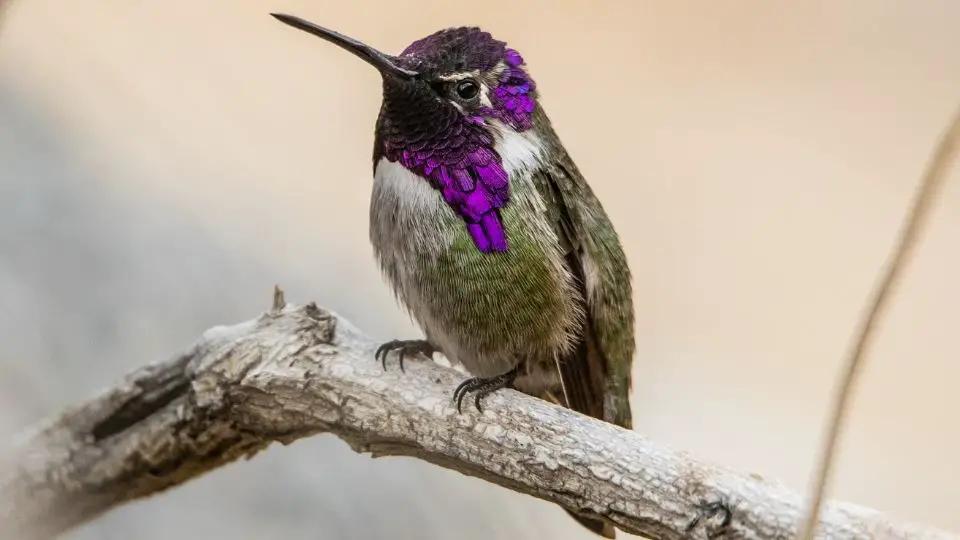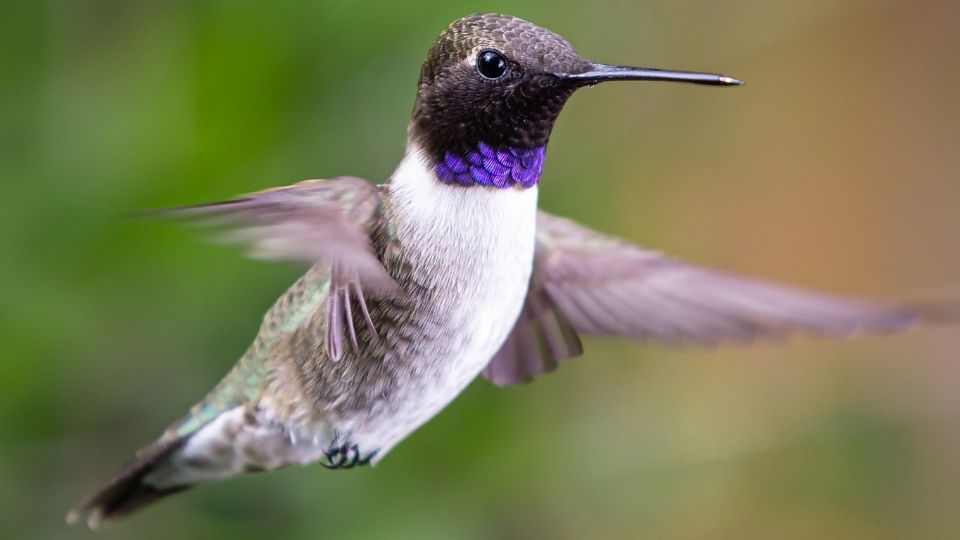While there are many hummingbirds in British Columbia, the most common ones are Anna's hummingbirds, Rufous, Ruby-throated, Black-chinned hummingbirds, Calliope hummingbirds, and Costa's hummingbirds.
British Columbia used to have other species of hummingbirds that unfortunately became rarer throughout time. Hummingbirds have slowly migrated south, away from Canada due to the unfavorable conditions of cold weather. However, you can still see them in some areas. These species include Rivoli’s Hummingbird, Broad-tailed Hummingbird, and Mexican Violetears.
It’s essential to recognize these hummingbird species and protect them. These pollinators have an indispensable role in the life cycle of flowers and overall ecosystem. Providing support to this population of hummingbirds can be as easy as providing feeding stations for your local migrants.
Table of Contents
7 species of hummingbirds that are common in British Columbia
Let’s see what makes each hummingbird species different so that you can instantly recognize it whenever you see one.
Here is our list:

Anna’s hummingbird
Out of all hummingbirds, you can spot these little birdies in the Lower Mainland during the winter. Anna’s hummingbirds are small-sized birds that have a green and gray appearance on their bodies. The male has an impressive iridescent pink gorget (throat feather) while females do not have this feature – instead, they have a gray throat with red spots.
Unlike other hummingbirds, these tiny birds are not migrators, so they prefer to stay in one place. Anna’s Hummingbirds spend their time in Southern Columbia. You can also spot them on Vancouver Island, Ontario, Victoria, and Pacific Coast.
Anna hummingbirds are particularly sensitive to a cold snap – the cold Vancouver weather can take a tremendous toll on them. But that might be because they are the most spotted hummingbird during winter. Most hummingbirds migrate during this season. They love to feast on tree sap, small insects, and nectar.

Rufous Hummingbirds
Male rufous Hummingbirds are “red-throated” hummingbirds – their bright red throats are easy to spot in the wild! Apart from that, the rest of their body is primarily orange, making them stand out. Females have a green and brown body with rusty spots on the side and a white belly. They migrate for long distances – specifically, from Mexico to Alaska twice per year, which is no small feat.
As opposed to Anna’s hummingbirds, Rufous hummingbirds are mostly spotted during the summer. Rufous hummingbirds are the most aggressive species of hummingbirds, and they don’t steer away from fighting other hummingbirds. Sadly, the number of Rufous hummingbirds in British Columbia has declined significantly during the last decades.

Calliope hummingbirds
The Calliope hummer is the smallest and most light-weight species of hummingbird. They’re usually spotted in British Columbia from March to October. Males are hard not to notice, as they have magenta iridescent streaks on their throats. The rest of their body is a combination of metallic green and white. The females have metallic green and white bodies and dark spots all over their throats.
Male calliope hummingbirds also stand out through with their their ritual-dance, a U-shaped dive that is performed to impress females. These sneaky hummingbirds are known for hawking – they spy on small insects and catch them mid-air. They also hunt insects that are caught in spider webs. Calliope hummingbirds usually enjoy breeding season tremendously and take full advantage of it.

Costa’s hummingbirds
These hummers sightings are rare in British Columbia, but you can spot some in Vancouver and Abbotsford. They seem to be more common in Baja California, Southern California, and southwestern Arizona. Males have iridescent purple throats and a purple crown. Females are duller, but their bellies are more white.

Rivoli’s Hummingbird
The Rivoli’s Hummingbird is a rare hummingbird species, but some have been spotted in British Columbia, albeit not too often (last spotted in 2017). They are a bigger size than most hummingbirds. Males are striking, having an impressive iridescent throat and crown.
Females don’t have this feature; instead, their bodies are a combination of green and gray. They can usually be found in mountain areas as they build their nest at high altitudes.

Black-chinned hummingbird
The black-chinned hummingbird is one of the most common species of hummingbirds in Canada. The male has a luscious purple vibrant chin and a metallic green body, while the female has white tail feathers and a light-colored throat.
Black-chinned Hummingbirds breed during summer, and they migrate to Mexico during the winter. The black-chinned hummingbird makes a bee-like sound when flapping its wings.

Ruby-throated Hummingbirds
You can also see the ruby-throated hummingbird species most during the summer in BC. Males have a green back and crown, and the throat has an iridescent red color. They usually don’t stick around after mating.
Female Ruby-throated Hummingbirds don’t have this last feature – the back is green, their belly white, with brown sides. They usually lay 1 to 3 tiny eggs. The Ruby-throated Hummingbird migrates to Central America, the Gulf of Mexico, and Texas during the winter.
How to attract a hummingbird?
The primary way to attract hummingbirds is by offering them food they enjoy. Nectar Bird feeders attract hummingbirds – Nectar from flowering plants is a hummers’ primary food source, but you can make nectar by mixing white sugar and water (sugar water). More specifically, one part sugar to 4 parts water.
Don’t use artificial sweeteners, as they won’t provide all the nutrition that hummingbirds need. The Wildlife Rescue Association urges us that it would be preferable not to use molasses to feed the hummingbirds. Most hummingbirds also love tubular flowers and bright red colors – so you can consider that if you want to attract them.
If you offer comfort and respect to hummingbirds, they tend to stick around in your garden. Hummingbird nests should be left alone – not disturbed – if you don’t want them to leave. Attracting hummingbirds during the winter can be more tricky.
Hummingbirds can enter a state of torpor in which they significantly lower their body temperature to survive freezing temperatures. If you want to see them during this time, it’s recommended that you leave hummingbird feeders outside and not bother them while they’re sleeping.

